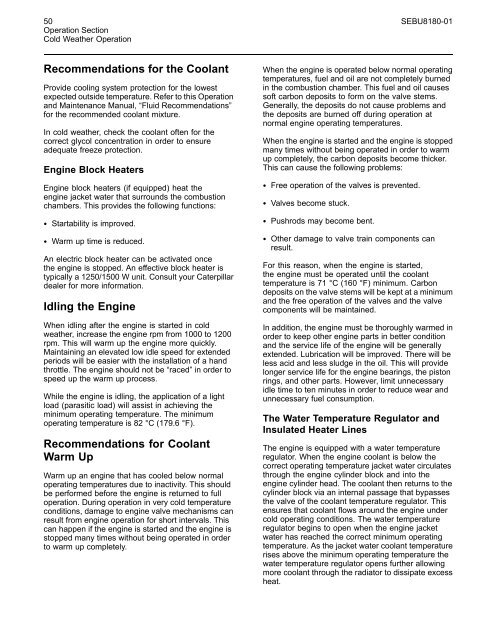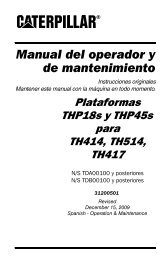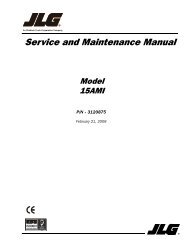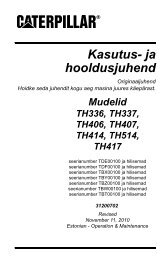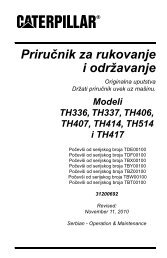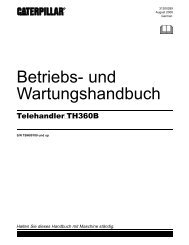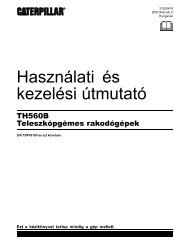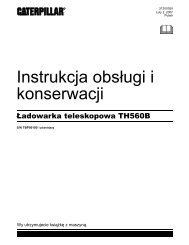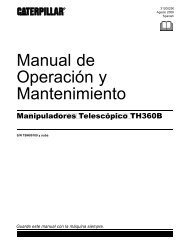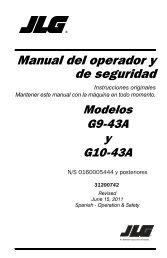Operation and Maintenance Manual
Engine - JLG
Engine - JLG
- No tags were found...
You also want an ePaper? Increase the reach of your titles
YUMPU automatically turns print PDFs into web optimized ePapers that Google loves.
50 SEBU8180-01<br />
<strong>Operation</strong> Section<br />
Cold Weather <strong>Operation</strong><br />
Recommendations for the Coolant<br />
Provide cooling system protection for the lowest<br />
expected outside temperature. Refer to this <strong>Operation</strong><br />
<strong>and</strong> <strong>Maintenance</strong> <strong>Manual</strong>, “Fluid Recommendations”<br />
for the recommended coolant mixture.<br />
In cold weather, check the coolant often for the<br />
correct glycol concentration in order to ensure<br />
adequate freeze protection.<br />
Engine Block Heaters<br />
Engine block heaters (if equipped) heat the<br />
engine jacket water that surrounds the combustion<br />
chambers. This provides the following functions:<br />
• Startability is improved.<br />
• Warm up time is reduced.<br />
An electric block heater can be activated once<br />
the engine is stopped. An effective block heater is<br />
typically a 1250/1500 W unit. Consult your Caterpillar<br />
dealer for more information.<br />
Idling the Engine<br />
When idling after the engine is started in cold<br />
weather, increase the engine rpm from 1000 to 1200<br />
rpm. This will warm up the engine more quickly.<br />
Maintaining an elevated low idle speed for extended<br />
periods will be easier with the installation of a h<strong>and</strong><br />
throttle. The engine should not be “raced” in order to<br />
speed up the warm up process.<br />
While the engine is idling, the application of a light<br />
load (parasitic load) will assist in achieving the<br />
minimum operating temperature. The minimum<br />
operating temperature is 82 °C (179.6 °F).<br />
Recommendations for Coolant<br />
Warm Up<br />
Warm up an engine that has cooled below normal<br />
operating temperatures due to inactivity. This should<br />
be performed before the engine is returned to full<br />
operation. During operation in very cold temperature<br />
conditions, damage to engine valve mechanisms can<br />
result from engine operation for short intervals. This<br />
can happen if the engine is started <strong>and</strong> the engine is<br />
stopped many times without being operated in order<br />
to warm up completely.<br />
When the engine is operated below normal operating<br />
temperatures, fuel <strong>and</strong> oil are not completely burned<br />
in the combustion chamber. This fuel <strong>and</strong> oil causes<br />
soft carbon deposits to form on the valve stems.<br />
Generally, the deposits do not cause problems <strong>and</strong><br />
the deposits are burned off during operation at<br />
normal engine operating temperatures.<br />
When the engine is started <strong>and</strong> the engine is stopped<br />
many times without being operated in order to warm<br />
up completely, the carbon deposits become thicker.<br />
This can cause the following problems:<br />
• Free operation of the valves is prevented.<br />
• Valves become stuck.<br />
• Pushrods may become bent.<br />
• Other damage to valve train components can<br />
result.<br />
For this reason, when the engine is started,<br />
the engine must be operated until the coolant<br />
temperature is71°C(160°F)minimum.Carbon<br />
deposits on the valve stems will be kept at a minimum<br />
<strong>and</strong> the free operation of the valves <strong>and</strong> the valve<br />
components will be maintained.<br />
In addition, the engine must be thoroughly warmed in<br />
order to keep other engine parts in better condition<br />
<strong>and</strong> the service life of the engine will be generally<br />
extended. Lubrication will be improved. There will be<br />
less acid <strong>and</strong> less sludge in the oil. This will provide<br />
longer service life for the engine bearings, the piston<br />
rings, <strong>and</strong> other parts. However, limit unnecessary<br />
idle time to ten minutes in order to reduce wear <strong>and</strong><br />
unnecessary fuel consumption.<br />
The Water Temperature Regulator <strong>and</strong><br />
Insulated Heater Lines<br />
The engine is equipped with a water temperature<br />
regulator. When the engine coolant is below the<br />
correct operating temperature jacket water circulates<br />
through the engine cylinder block <strong>and</strong> into the<br />
engine cylinder head. The coolant then returns to the<br />
cylinder block via an internal passage that bypasses<br />
the valve of the coolant temperature regulator. This<br />
ensures that coolant flows around the engine under<br />
cold operating conditions. The water temperature<br />
regulator begins to open when the engine jacket<br />
water has reached the correct minimum operating<br />
temperature. As the jacket water coolant temperature<br />
rises above the minimum operating temperature the<br />
water temperature regulator opens further allowing<br />
more coolant through the radiator to dissipate excess<br />
heat.


